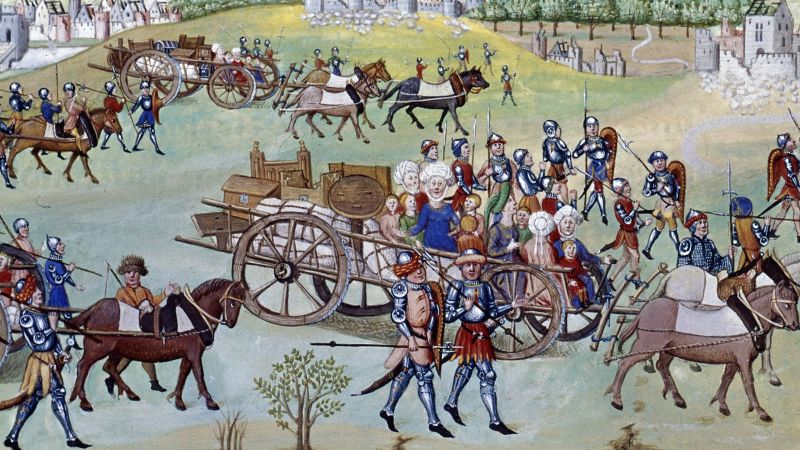[Travelers have always faced health hazards when far from home. Medieval people were no exception. Pilgrims, crusaders and others were warned by preachers such as 13th-century Jacques de Vitry of “dangers on land, dangers at sea, the dangers of thieves, the dangers of predators, the dangers of battles.”
There were also dangers to health: disease, lack of good nutrition and water, injury, accident and poisoning. Medieval travelers were active and innovative in trying to prevent ill health while away.
One especially interesting set of practical health care instructions for travelers is the “De regimine et via itineris et fine peregrinatium” (“About the regimen and way of the journey for the traveler”). The text was composed by Adam of Cremona in about 1227–28 for the German emperor Frederick II, who was about to set out on crusade.
Adam advised bloodletting (phlebotomy) should be performed prior to the emperor’s journey and then regularly throughout, depending on the “will and mood” of the stars. Bloodletting was central to medieval medical practice. It used leeches or sharp knife-like instruments to nick the vein and cause blood to drain from the body.
Adam devoted some 25 chapters of his text to phlebotomy, drawing on the idea that bloodletting would regulate the humors (the four fluids thought to make up the body: blood, yellow bile, black bile and phlegm), evacuating “bad” ones and setting the body in balance to prepare for healthy travel.
While the concept of the four humors has since been abandoned by modern medicine, bloodletting and “leech therapy” continue to be performed in some medical settings for specific purposes.
Adam advised all travelers should be mindful of the instruments of bloodletting — especially leeches — while on the road. His writing included warnings to distinguish between leeches: good (round and shiny) and bad (black or blue in color and found near fetid water).
He also gave careful instruction on how to desalinate water, as well as advice about diet (as close as possible to the traveler’s home diet, with plenty of fruit and vegetables), the importance of rest and adequate sleep, and the importance of regular bathing.
Dysentery was a well-known hazard of travel, especially for crusaders, and Adam’s guide reflected all travelers’ wish to avoid it by keeping the digestive system in balance.
Knowledge about water supplies was especially important for travelers. One pilgrimage guide informed travelers that one of the best sources of water in the holy land was just outside Haifa, in modern-day Israel.
Medieval travelers were also reminded to take particular care of their feet. In 1260, Vincent of Beauvais gave instructions to travelers to use poultices (a dressing for wounds) made of oil, plants and quicksilver (mercury) to prevent and manage blisters — an all too frequent ailment experienced by pilgrims walking long distances.
Adam of Cremona suggested travelers regulate their pace as they walked, especially on unfamiliar and rough roads. The overall benefit of exercise was generally understood. Preachers such as Jacques de Vitry told congregations movement made the body healthy both physically and spiritually, so should be undertaken regularly before and during a journey.
Different climates and environments meant encounters with dangerous fauna. The holy land was said to be home to poisonous serpents. Travelers took with them theriac, an antidote made in part from snake flesh, in case of a bite. This would be ingested or smeared on the wound.
Crocodiles in Egypt were also often mentioned as a hazard. There were no antidotes for an attack, but forewarning travelers with knowledge helped them to remain alert.
Medieval travelers did not leave their fate entirely in God’s hands. Even the crusaders took precautionary measures to balance both bodily and spiritual health before and during their journeys.
They confessed sins, sought blessings to protect their property and baggage and carried with them charms and amulets that were thought to ensure “the health of body and protection of the soul”, as one 12th-century Italian blessing explained. This “divine prophylaxis” ran alongside more practical care of the physical body — a holistic view of health as corporeal and spiritual.
The actions and remedies available to medieval pilgrims and other travelers may seem limited and perhaps dangerous to modern readers. But like all travelers, medieval people used the knowledge they had and tried hard to maintain good health in sometimes difficult conditions.
The urge to remain well is a very human one, and its long medieval history reminds us that good health has always been carefully managed through prevention just as much as cure.
Source link

